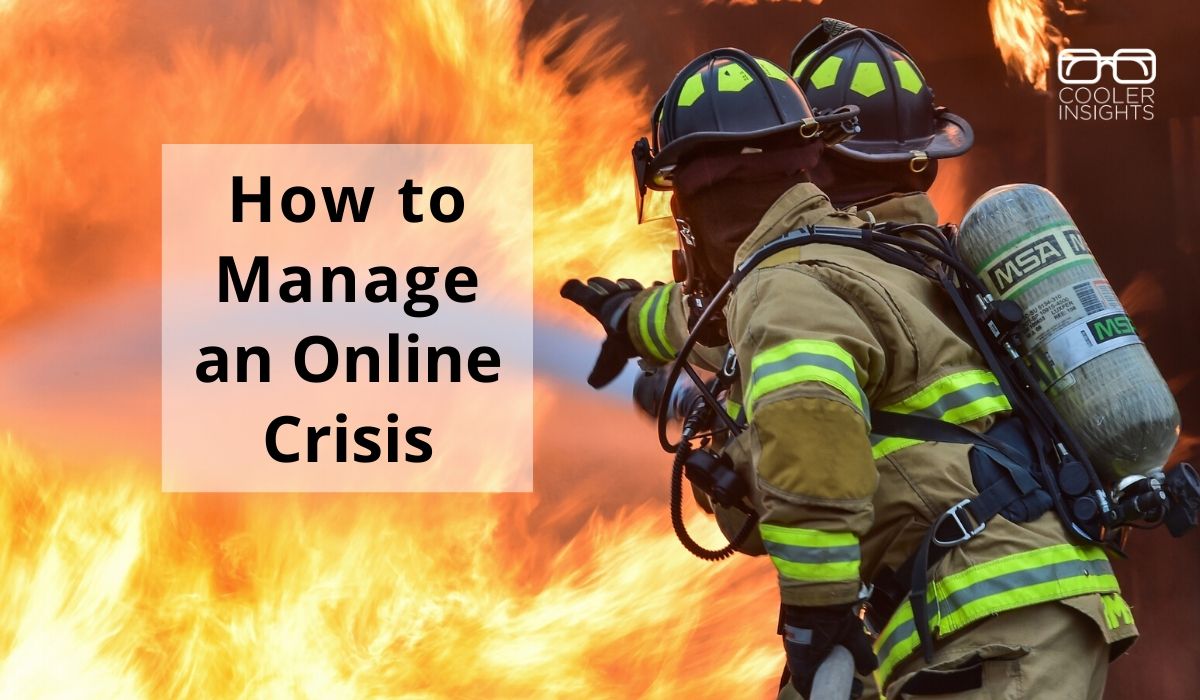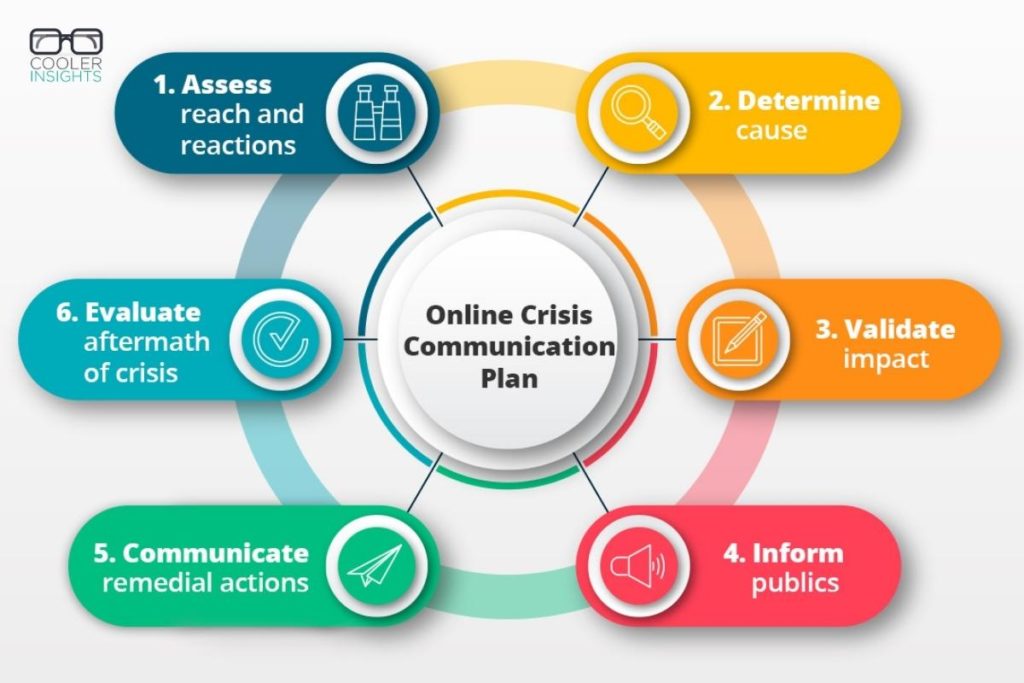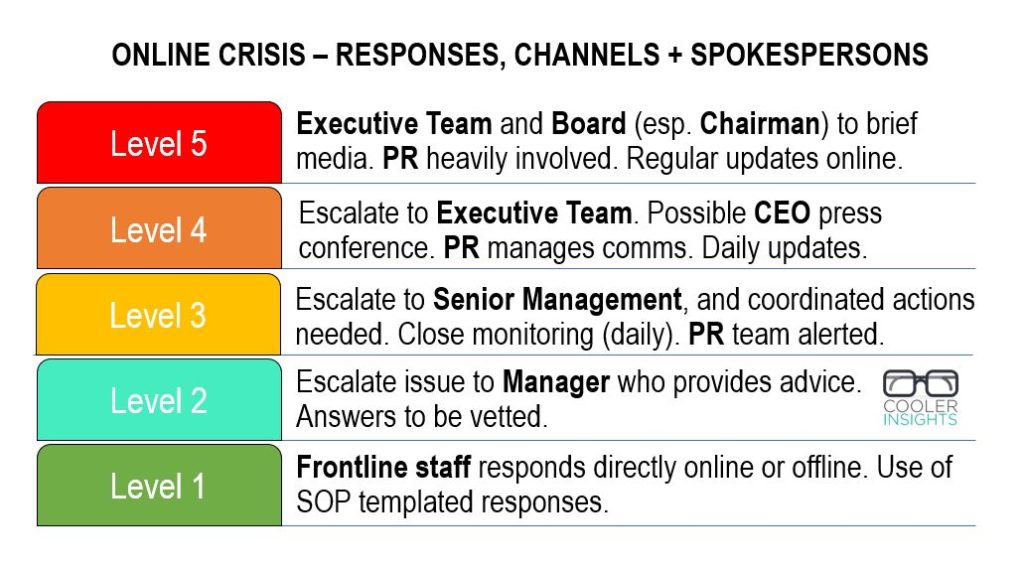
Social media is a good servant but a bad master. Especially when you’re battling a crisis.
From service failures and rogue employees to product quality issues—virtually any lapse can be blown out of proportion online.
No PR person in their right mind welcomes a crisis. Having experienced a few as a 15-year PR veteran myself, I know how stressful they can be.
Thankfully, there are best practices in crisis communications and management. These timeless principles apply across all your online platforms—from your website/blog, Facebook page, LinkedIn page, Twitter account, emails to any other social media channel.
What I’m going to show you today is a 6-step Online Crisis Communication Plan you can use to manage any online crisis. Depending on the response to this post, I may flesh it out into a full-fledged workshop on online crisis PR and management.
To make it easier for you to remember, I’ve used the acronym ADVICE:
- Assess reach and reactions
- Determine cause
- Validate impact
- Inform publics
- Communicate remedial actions
- Evaluate aftermath of crisis
Let’s look at each of these 6 steps in sequence. To make it convenient for you, I’ve included an infographic below:

#1 Assess Reach and Reactions
Not every bad online episode is a crisis. On the contrary, the majority of negative online events are run-of-the-mill customer service issues.
In assessing the severity of online chatter surrounding your brand, you need to ask yourself the following questions.
- What is the potential reach (ie readers, viewers, or listeners) of the negative news?
- Were there any social media influencers involved in the event? How influential are they (evaluate their reach and follower-base)?
- What about the mainstream media? Have they picked up the news?
- What about the audience reactions to the news? Are they liking, commenting and sharing it on Facebook, Instagram, LinkedIn or Twitter? Has it gone viral (see United Airlines PR crisis)?
- Concurrently, you need to assess internal stakeholder (ie employee or board member) reactions. Have they started to talk about it? What about on social media?
A good way to measure your online reach is to use a social listening tool, like BuzzSumo, Social Mention, Mention, Google Alerts, Keyhole, or others. Use a combination of these tools to assess the potential reach as well as their reactions and resonance (ie virality) to the news.
#2 Determine Cause of Crisis
After you’ve assessed the potential spread of the news, your next job is to ascertain the cause of the issue.
Use the following 5W and 1 H checklist as you start to investigate:
- WHO were involved in the issue? Include your staff, customers, members of the public, suppliers or anybody else involved.
- WHAT were they doing at that time?
- WHEN did the issue occur? Note that timeliness is everything in the near real-time speed at which information travels.
- WHERE did the issue occur? This should cover both the online or offline channels where the issue happened.
- HOW did it erupt into an issue? If possible, try to develop a chronology of events as they occur.
- WHY did it occur? Ascertain the cause and effect behind the issue, rather than lay blame at the earliest opportunity.
So how long should such internal investigations take? If you ask me, I’d say that you should try to complete it as soon as possible, preferably within a day. However, for more complex crisis involving multiple parties, it could take longer.
#3 Validate Impact of Online Crisis
Once the detective work is done, you need to evaluate the severity of the issue’s impact.
How bad is the impact of the issue? How will it affect your corporate reputation?
In doing so, you could come up with an Online Crisis Scale to measure the impact from 1 to 5. This could look like the following:

Each of the crisis level corresponds to a colour code, and they involve an escalating level of impact:
- CODE GREEN (Level 1): Occasional complaints or customer unhappiness. Issue can be resolved directly with rapid staff intervention.
- CODE TURQUOISE (Level 2): Multiple angry customers, or a consistent failure. Issue still hasn’t blown up, but could do so if not addressed.
- CODE YELLOW (Level 3): Issue has grown online, with unhappy parties lobbying. Some influencers may share the issue on their networks.
- CODE ORANGE (Level 4): Issue has blown up and mainstream media has reported on it. Issue has gone viral.
- CODE RED (Level 5): Extensive and ongoing media coverage, and issue may have attracted law suits and police investigations.
In thinking about the crisis levels of your issue, you should also consider the following reputational risks:
- Product Brand Risk: Will this affect your product’s reception in the marketplace?
- Corporate Brand Risk: Will this influence your company’s reputation?
- Talent/Employee Risk: How will this affect your staff morale and dignity? Will they quit following this?
- Governance Risk: Will this issue change how your company is managed? Will it come under greater scrutiny?
- Financial Risk: How will this impact your bottom-line performance?
- Shareholder Risk: What will be the impact on your shareholders? Will they sell your shares?
#4 Inform Your Publics
Once you’ve validated the impact of the issue on your company, you need to start communicating to the parties involved.
Now this will depend on the level of Crisis, and the adequacy of your levels of response. The infographic below shows the proposed level of responses, seniority levels of respondees/spokespersons, and types of responses needed.

Depending on the severity of the issue, different levels of staff should be involved. While Level 1 and Level 2 issues can be managed directly by the frontline teams, any incidents which involve online reports should be escalated to senior management and the Public Relations (PR) or Corp Comms team.
Once your crisis (touch wood!) hits Levels 4 or 5, PR needs to be directly involved. Regular updates online are also needed. This could be Facebook posts, Tweets, Blog posts, or LinkedIn posts, depending on the severity of the incident.
As a rule of thumb, crises that are widely reported on mainstream and social media has to be addressed on your website and social media channels. Doing so allows you to present your side of the story.
Staff Activation Levels: Online Crisis Comms
Depending on the severity of the issue, you should consider the following formats in communication:
- CODE GREEN (Level 1): Direct customer replies by front-line officer
- CODE TURQUOISE (Level 2): Longer and more well thought out online responses by frontline officer or manager, cleared by manager
- CODE YELLOW (Level 3): Responses to be cleared by senior management, and PR. An official statement to be posted on social media (Facebook, LinkedIn, Instagram). Crafting of holding statements ready.
- CODE ORANGE (Level 4): PR team to be mobilised, with daily online updates on the crisis. If necessary, press statements with quote from CEO could be crafted.
- CODE RED (Level 5): Legal team to be consulted, and press briefing by Chairman (or the top man in the organisation). Updates every few hours on social media may be needed.
#5 Communicate Crisis Comms Remedial Actions
In all your communications to your publics, you need to inform them on what occurred and how you are rectifying the issue. This is so important!
You need to be specific enough to satisfy the mob/online vigilantes, yet not reveal all your trade secrets.
Typically, these should include any (or all) of the following actions:
- Immediate actions taken to stem the flow. For example, recalling all defective products. Or sacking the rogue employee. Or putting out the (literal) fire.
- Short term actions to identify cause. This normally includes internal investigations, Board Of Inquiries (BOI), or setting up a task force to trouble-shoot the issue.
- Medium-term actions to ensure issue doesn’t repeat itself. This could include changing of processes or SOPs, replacing of equipment, or getting a third-party expert to help rectify issue.
- Long-term actions to strengthen governance, for example by re-organising the company, change reporting structures, conduct crisis management exercises, or incorporate new culture-building activities to weed out toxic behaviours.
#6 Evaluate Aftermath of Crisis (Online and Offline)
After the crisis or incident has blown over (phew!), it isn’t time for you to rest yet…
The best organisations conduct a post-mortem of the crisis. This includes the following:
- Measuring and evaluating the total media/social media impact of the crisis. This should include both quantitative and qualitative indicators like Reach, Impressions, Media Value (or Advertising Equivalent Value, ie AEV), virality, and so on.
- Documenting of the chronology of the incident, all the way until it is resolved. This should be filed properly yet easily accessed by parties who need to consult it.
- Documenting of all learning points and remedial actions taken.
To strengthen the crisis preparedness of the organisation, it may be useful to also conduct table-top exercises for crisis management scenarios. This could cover the specific situation which erupted into the crisis, as well as other similar scenarios.
Oh, and one last thing.
You need to have a crisis management and communication plan! If you haven’t already crafted one, it is timely for you to do so.
Conclusion
In the almost real-time age of social and digital media, online crises can erupt virtually any hour.
Cowering in fear or responding vigorously to every online challenge isn’t going to be fruitful in the majority of cases.
With the ADVICE framework, you now have a robust 6-step Online Crisis Communications Plan to tackle any crisis:
- Assess reach and reactions
- Determine cause
- Validate impact
- Inform stakeholders
- Communicate remedial actions
- Evaluate aftermath of crisis
Have you encountered an online crisis in your organisation? How did you respond to it?
Need Help with Your Digital PR?
Fill in the contact form below for a free 30-minute Skype or Zoom consultation session!
